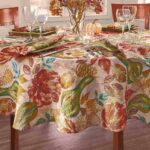napkin

 Tablecloths…usually used to dress up a table, often for a holiday dinner these days, were not always used for that purpose. Children wiping their mouths on tablecloths isn’t generally acceptable at the dinner table these days, but that was their original use! It was like a community napkin. Guests were meant to wipe off their hands and face on a tablecloth after a messy feast, and not do this would be considered bad table manners! These days it’s pretty much the opposite. The idea is to try not to “spill” or otherwise mess up the tablecloth.
Tablecloths…usually used to dress up a table, often for a holiday dinner these days, were not always used for that purpose. Children wiping their mouths on tablecloths isn’t generally acceptable at the dinner table these days, but that was their original use! It was like a community napkin. Guests were meant to wipe off their hands and face on a tablecloth after a messy feast, and not do this would be considered bad table manners! These days it’s pretty much the opposite. The idea is to try not to “spill” or otherwise mess up the tablecloth.
While original tablecloths were usually white…another odd idea, considering the practice of wiping one’s mouth and hands with the cloth, today’s version is often colorful, and decorative to match the holiday currently being celebrated. The most common shapes for tablecloths are round, square, oval, and oblong, or rectangular, corresponding to the most common table shapes. Tablecloths usually have an overhang, referred to as the “drop” of about 6 to 15 inches on each side of the table. The shorter drop is usually for casual dining and a longer drop for more formal occasions. Sometimes a floor-length cloth is used. Custom-made tablecloths are also available, and some people choose to make their own.
Some tablecloths are just decorative, and often used on a wooden table to help protect the table from scratches and stains. Others are designed to be spread on a dining table before laying out tableware and food. In formal settings, tablecloths are designed as part of an overall table setting, with coordinating napkins, placemats, or other decorative pieces, and in very formal settings the might also be “runners” overhanging the table at two ends only and “table protectors” which provide a padded layer under a normal tablecloth.
Today’s more casual, and less expensive tablecloths are typically made of cotton, and some have a poly-cotton blend, or a PVC-coated material that can be wiped clean. Of course, any material works, and some people use delicate fabrics like embroidered silk. Today, the biggest consideration, at least in casual settings, is ease of cleanup, so the material might be chosen for its ability to fight stains.
Of course, one more use for a tablecloth, was in shows, where the tablecloth is quickly pulled from under a set table full of food. The idea is to pull it quickly enough to leave the table’s contents in place while pulling the cloth from under them. This trick relies on inertia. It is known as a tablecloth pull or a tablecloth yank. Unless 
 you are prepared for the cleanup following such a trick, I wouldn’t exactly recommend trying that one. I think most of us knew most of these uses, but maybe not the original use. Nevertheless, now you know. I would be careful using the tablecloth in that way at your next family dinner, however. It might not be appreciated.
you are prepared for the cleanup following such a trick, I wouldn’t exactly recommend trying that one. I think most of us knew most of these uses, but maybe not the original use. Nevertheless, now you know. I would be careful using the tablecloth in that way at your next family dinner, however. It might not be appreciated.
 When kids are little, the whole meal thing can be…well, a challenge. No kid is the same, and there are always things they don’t like to eat. To make matters worse, if you were raised in my generation, you were always told that you needed to clean up your plate, because there were children starving in Africa. It occurred to us that our not cleaning our plate was not going to help them anyway, but that was still the thing we were told. Of course, our parents were trying to teach us not to be wasteful, but when I was looking at tomatoes or peas…which I still do not really like, it didn’t make any difference, because I figured that if those children in Africa wanted my tomatoes or peas, they were welcome to them…just get me a to go box and I’d figure out a way to pay the postage.
When kids are little, the whole meal thing can be…well, a challenge. No kid is the same, and there are always things they don’t like to eat. To make matters worse, if you were raised in my generation, you were always told that you needed to clean up your plate, because there were children starving in Africa. It occurred to us that our not cleaning our plate was not going to help them anyway, but that was still the thing we were told. Of course, our parents were trying to teach us not to be wasteful, but when I was looking at tomatoes or peas…which I still do not really like, it didn’t make any difference, because I figured that if those children in Africa wanted my tomatoes or peas, they were welcome to them…just get me a to go box and I’d figure out a way to pay the postage.
My parents didn’t go for that, so I had to sit there until I cleaned up my plate. Yuck!! I tried everything I could think of to get out of it. I would put a forkful of peas in my mouth and then spit them into my napkin, but the darned things wouldn’t always stay in there, so I ended up getting them back. After a while, I learned how to make them stay in there pretty good, but I still got caught most of the time. Now tomatoes were a different story. Putting a forkful of stewed tomatoes in my mouth produced a pretty much instant gagging effect that was not faked, and trying to swallow was almost worse. I learned to plug my nose and swallow those nasty things whole…and quickly.
Sometimes, it isn’t a matter of not liking a food, but taking more than you can eat. My sister, Alena found that out on Thanksgiving one year, when she wanted to have the entire turkey leg. She argued with my dad about it until he finally gave in and let her have the entire turkey leg. Of course, she couldn’t eat it all, so Dad said she could have it the next day. Well, she still couldn’t eat it all, so she got it the next day…and the next. By that time it was covered with cranberry sauce and gravy, and just the  site of it made Alena cringe. Dad would get that silly turkey leg out every day, and try to hide his emotions when he handed it to Alena. Finally, the turkey leg ended up in the trash, and to this day, Alena doesn’t eat the leg on turkey or chicken.
site of it made Alena cringe. Dad would get that silly turkey leg out every day, and try to hide his emotions when he handed it to Alena. Finally, the turkey leg ended up in the trash, and to this day, Alena doesn’t eat the leg on turkey or chicken.
Yes, food can be an issue with kids , but eventually they outgrown that pickiness…or just grow up and move out, so they can make their own food choices. There are some things that I still don’t like…and probably never will, but as I found out recently with Avocados, it never hurts to try thing again once in a while, because your tastes might change. You never know, but tomatoes and peas…well not yet.

